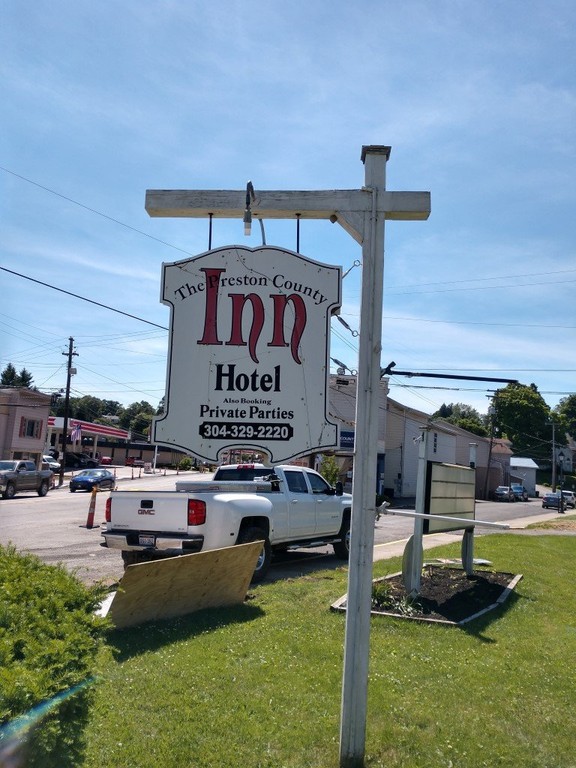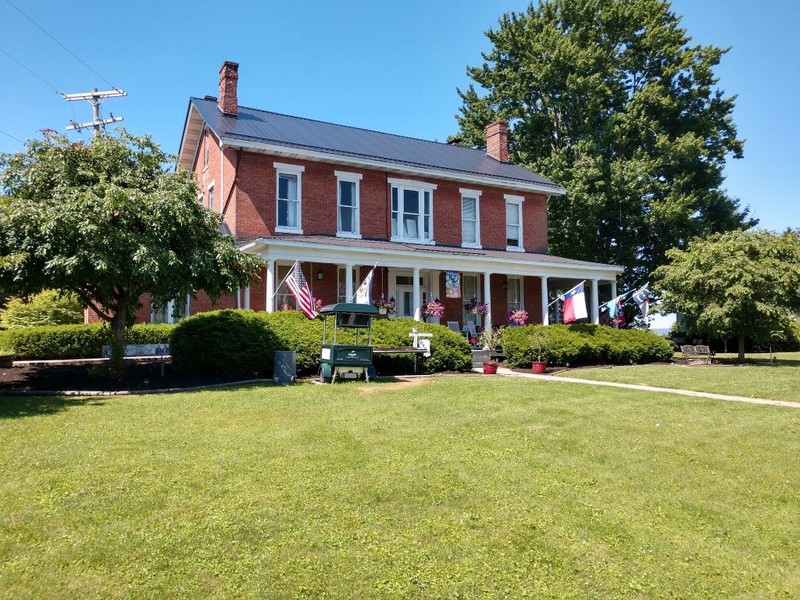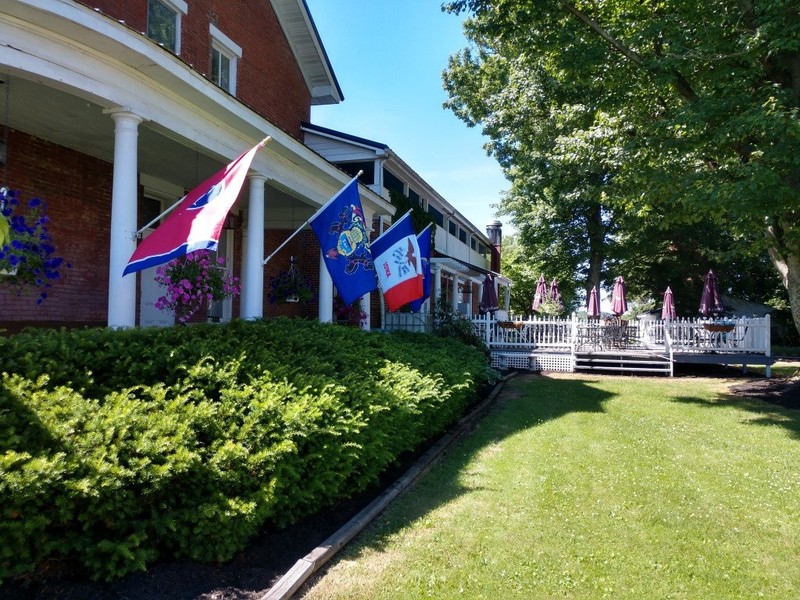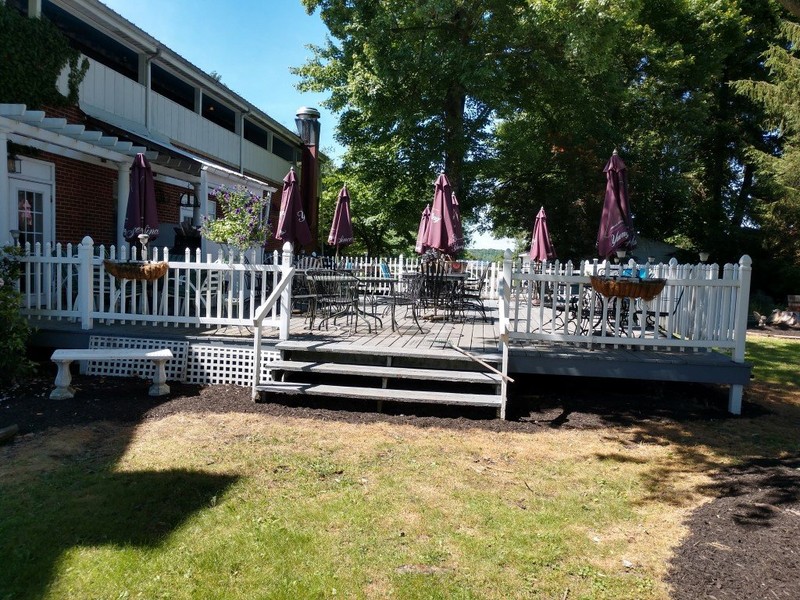The Preston County Inn
Introduction
Text-to-speech Audio
Images
Front Sign along West Main Street. Courtesy of Main Street Kingwood.

Front Porch (view from south to north). Courtesy of Main Street Kingwood.

Side Porch (east side of building). Courtesy of Main Street Kingwood.

Outdoor Patio (east side of building). Courtesy of Main Street Kingwood.

Backstory and Context
Text-to-speech Audio
According to local legend, when attorney James A. Brown constructed a house for his wife Isabel on Main Street in 1859 she did not care for the building's signature feature: the word "Home" printed across the structure's roof in colored slate. Still, their home it remained for the short duration of their marriage, which ended abruptly a year later when Isabel succumbed to smallpox. Built in the Federal style, with symmetrical, smooth features, side gabling, and stone lintels, the house that now operates as the Preston County Inn under Jean and Deb Guillot is most notable for its association with Brown himself. From the 1860s to the 1880s Brown played a prominent role in local politics, serving as prosecuting attorney for Preston County from 1861 to 1863 and running for judge of the Third Circuit Court in 1880. After his death, the house he built for Isabel passed through a number of hands before reopening as an inn in 1932. It has continued in that capacity since then, with the Guillots taking over operations after a visit to the area in 2007. They currently run a restaurant, which is open for lunch and dinner, and offer guest accommodations on the second floor. The inn is also noteworthy for its seven fireplaces, three of which are downstairs and four upstairs.
Shortly after his wife's untimely death the residents of Preston County elected James to serve as one of their prosecuting attorneys, which he did from 1861 to 1863. Preston County was predominantly pro-Union on the eve of the Civil War, most likely as a result of the area's dwindling reliance on slave labor over the course of the antebellum period. The proportion of slave to free labor in the county reached its peak in 1830, when there were 125 enslaved African Americans and 27 free Black residents listed in the census. By 1860, those numbers had shifted to 67 and 45 respectively, ensuring little sympathy for secession among the majority of Prestonians. Their representatives at the Virginia Secession Convention, James McGrew and William G. Brown, Sr., voted against leaving the Union, and worked to leave Confederate Virginia and form the state of West Virginia in 1863. While men like James McGrew worked to keep the entire region in the Union others, like James Brown, worked to ensure that federal law and authority remained in force on the local level. This task had considerable challenges. Union loyalties may have been strong in Preston County, but the area was not free of Confederate sympathizers and it was Brown's job as a representative of the criminal justice system to mediate any possible threat such individuals might have posed to federal governance there. He evidently performed well in this capacity, ultimately stepping down the same year that West Virginia became a state
While Brown's career in politics began with the outbreak of the Civil War, it came to a close with that era's conclusion. When he ran as a Republican in 1880 to become a judge of the Third Circuit Court, he enjoyed considerable support in Preston County but ultimately lost to the Democratic majorities that made up the rest of the counties in the circuit. He was by no means alone in defeat: Republicans across West Virginia and the United States had been steadily losing ground to Democratic candidates since the Compromise of 1877 resulted in Republican Rutherford B. Hayes ascending to the presidency. In exchange, Hayes agreed to remove the last federal troops from the southern states under Reconstruction, a deal that alienated many Republicans and allowed Democrats to gradually regain control of national politics by the 1890s. West Virginia took a slightly different path. The Democratic party that came to power at the expense of candidates like Brown dominated state politics until the election of 1896, when its voters rejected the Populist leanings of William Jennings Bryan. Instead they chose William McKinley, who promised to bring business back to the country during an economic downturn and campaigned extensively in the Mountain State.
The Brown house's transformation into an inn coincided with the next shift in state and national politics. The first iteration of the inn opened its door in 1932, just a few short years after the Great Depression drove voters in both West Virginia and the country to reject pro-business Republican candidates in favor of Franklin Roosevelt's Democrats. The economic downturn hit Preston County particularly hard but the inn remained open, changing hands by continuing as an inn from then to the present. Its current owners, the Guillot family, operate a restaurant serving lunch and dinner there and offer accommodations in the guest rooms on the second floor. They have also pieced together a detailed history of the building and James Brown, which is available on their website.
Sources
Atkinson, George W., and Alvaro F. Gibbens. Prominent Men of West Virginia: Biographical Sketches of Representative Men. Wheeling, W. Va.: W.L. Callin, 1890.
Dahlia, John. "The Preston County Inn, Forging a New Path for an Old, Historic Business." The Preston County News & Journal, February 2, 2016. Accessed May 25, 2019. https://www.wvnews.com/prestoncountynews/lifestyles/the-preston-county-inn-forging-a-new-path-for-an/article_f6dccdd9-13e0-53ac-8540-c7a130151658.html &cd=4&hl=en&ct=clnk&gl=us.
Mann, Ralph "Reconstruction." e-WV: The West Virginia Encyclopedia. 22 October 2010. Web. 25 May 2019.
Morton, Oren F., and J.R. Cole. A History of Preston County, West Virginia. Preston County, WV: Journal Publishing Company, 1914.
Rupp, Robert "Republican Party." e-WV: The West Virginia Encyclopedia. 22 November 2016. Web. 25 May 2019.
Snell, Mark A. West Virginia and the Civil War: Mountaineers Are Always Free. Charleston, SC: History Press, 2011.
Ward, Bryan. Kingwood Preservation Plan. Morgantown, WV. West Virginia University, 1997. This book was produced by the Eberly College of Arts and Sciences, Institute for the History of Technology and Industrial Archaeology at West Virginia University for Main Street Kingwood. Printed in the United States of America Copyright 1997 Main Street Kingwood. All rights reserved. Cover illustration by Paul Boxley and cover photograph courtesy of W.G. (Bill) Williams. Main Street Kingwood, 101 East Main St., P.O. Box 357, Kingwood, WV 26537
